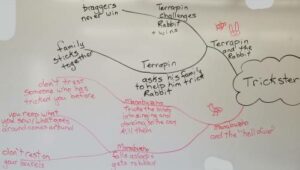English First Peoples 12 – Universality of the Trickster
Adapted from FNESC/FNSA English First Peoples 10, 11, and 12 Teacher Resource Guide
Learning Objectives
- Recognize and identify personal, social, and cultural contexts, values, and perspectives in texts, including gender, sexual orientation, and socio-economic factors
- Appreciate and understand how language constructs and reflects personal, social, and cultural identities
- Demonstrate understanding of the role of story and oral traditions in expressing First Peoples perspectives, values, beliefs and points of view
Purpose: Create a concept map of Trickster stories of your choice from various cultures and break them down into the lessons taught/learned by the Trickster.
Description: Your task is to create a concept map including a minimum of 4 stories, you may only use one story that we covered in class in a digital presentation (Sway or Canva).
- Include the name of the Trickster, the main events of the story and the lessons learned/taught by the Trickster. Do not provide a summary of the entire story.
- Display an image of the Trickster featured in the story.
- Correctly cite all sources in an MLA Bibliography.
Responsibilities: If working in a group, each person is responsible for contributing 2 individual stories to the concept web. It must be clearly indicated which stories were completed by the group and those by individuals. Individual assessment will be worth more than that of the group.
Time Scale: 6 class periods

Exemplar of Trickster concept map

Leave a Reply
You must be logged in to post a comment.